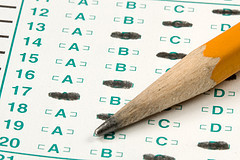SCENE: Camera pans into The Principal’s Office. Teacher has been invited in for their end of year reflection conference. Principal has raised concerns about the high number of students on track to earn an F in Teacher’s 1st, 2nd, 3rd, and 4th period classes. [Editor’s note: The characters represented below are not intended to serve as proxy for all principals or all teachers…]
PRINCIPAL [P]: Thanks for coming in, and I see you have your data with you [gestures to the stack of unnecessary spreadsheets the teacher is carrying].
TEACHER [T]: Of course. It really looks like the kids blew it this year. I’ve never had so many Fs in my whole career.
P: That must be frustrating. This has been an unprecedented year, according to everyone everywhere. Tell me about these Fs. It looks like from what I can see in Skyward, almost half of all of your students across all four classes have below a 50%. It looks like, though, when those kids don’t have zeros on their work, they are getting mainly As and Bs on assignments. What do you feel like is going on there?
T: Yeah, they just aren’t doing the work.
P: Hmm. What sorts of work have you been assigning them to do?
T: Typical stuff. The same stuff we’ve always done. I’ve never had so many kids just not do the work as this year. Worksheets, homework, reading assignments, there’s no trend, really, it’s just that they’re not doing the work or they’re just not turning it in. I remind them, I tell them to, but their engagement just sucks.
P: [Slowly nods and takes a deep breath] I see. What do you think is getting in the way of them doing the work or not turning it in? Maybe something to do with what’s going on in the world right now?
T: No, they’re coming to school on in-person days, and they’re even coming to zooms. They’re just not doing the work.
P: Tell me about your response to this situation. How are you providing feedback to them about their performance? What sorts of support or differentiation have you tried?
T: Well, they get zeros in the grade book. [Tosses grade book printouts onto the table between P and T.] They know they’re supposed to be doing the work. They’ve gotta learn that they can’t just not do what they’re told to do. That’s a life skill. What’s gonna happen when they’re in a job someday and they just don’t do what their boss says? No more job. No paycheck. In school, that’s a zero.
P: So it sounds to me like you are attempting to prepare them for real world responsibility.
T: Exactly. Gotta hold them accountable. No work, no score.
P: You’re intending to teach responsibility and then hold them “accountable.”
T: Exactly.
P: So tell me again, what is it that you are doing to teach responsibility?
T: They get zeros in the gradebook when they are too lazy to do the work and turn it in.
[Principal cringes, takes a deep breath, mentally runs through HR deadlines and CBA just-cause procedures.]
P: That sounds more like you are testing their responsibility.
T: I don’t get it.
P: It sounds like giving them zeros in the grade book isn’t teaching them responsibility, it is testing their responsibility.
T: I still don’t follow.
P: Let’s think of a math example. If you were going to teach the students the quadratic formula or the parts of a cell or how to decode a poem, what would that look like?
T: Lessons, examples, practice, a few quizzes, probably a final test.
P: So what do lessons, examples, practice, a few quizzes, and a final test look like when you are teaching responsibility? What might I see if I were observing this in a classroom setting?
T: [Visibly frustrated] I don’t get what this has to do with anything. They aren’t doing the work. I’m giving them zeros to teach them a lesson, I guess.
P: Okay. But you said that in “teaching,” the lesson’s just the first stage. You said [checks notes] “lessons, examples, practice, a few quizzes, and a final test.”
T: It’s a lesson they gotta learn! If I don’t give them zeroes how else are they going to learn responsibility?
P: Are they learning responsibility when you give them the zero?
T: I don’t understand.
P: If the “lesson” to teach responsibility is to give the kid a zero, what evidence might you have that this lesson is achieving its desired effect?
T: They get zeros for not turning things in. That teaches them the lesson.
P: I feel like we have a disconnect here. This is what I am asking you to consider: First, you’ve been giving students zeros all semester.
T: Yes, when they don’t do the work.
P: Have you found that getting a zero on missing work teaches the student responsibility, teaches them to avoid missing work in the future?
T: No. It’s all the same kids [taps on printouts], they just don’t do the work.
P: So it is clear that giving them zeros is not actually teaching them responsibility…
T: [interrupts] …nope, they just keep not doing the work.
P: …so have you considered that maybe your lesson on responsibility isn’t actually working?
T: So you’re saying I’m not allowed to give zeros? Fine, everyone gets an A!
P: That’s not at all what I’m saying. I’d just like you to reflect on what the lesson is that you’re trying to teach and whether the lesson is actually resulting in the student learning what it is you want them to learn.
T: How are they supposed to learn responsibility if I don’t give them zeros?
P: The same way they learn anything else: You teach the skill intentionally before you expect them to perform it. You give them examples, guidance, and feedback. You give them a safe place to fail now so they won’t fail later. You give them opportunities to demonstrate the skill, reflect on their mistakes, revise their thinking and their practices. I’m not saying don’t give zeros, necessarily. I’m saying that when you put a zero in the gradebook, you are testing them on a skill you haven’t explicitly taught them. High school is where students are supposed to learn the skills that keep them from the kinds of consequences you described: losing jobs, losing paychecks. When you give the zero, you’re taking away the paycheck, you implied that yourself. My question to you: What are you doing to teach responsibility, not just test responsibility?
END SCENE: Camera pans away, Teacher’s scrunched brow indicates they are clearly wrestling with this new concept of responsibility.














